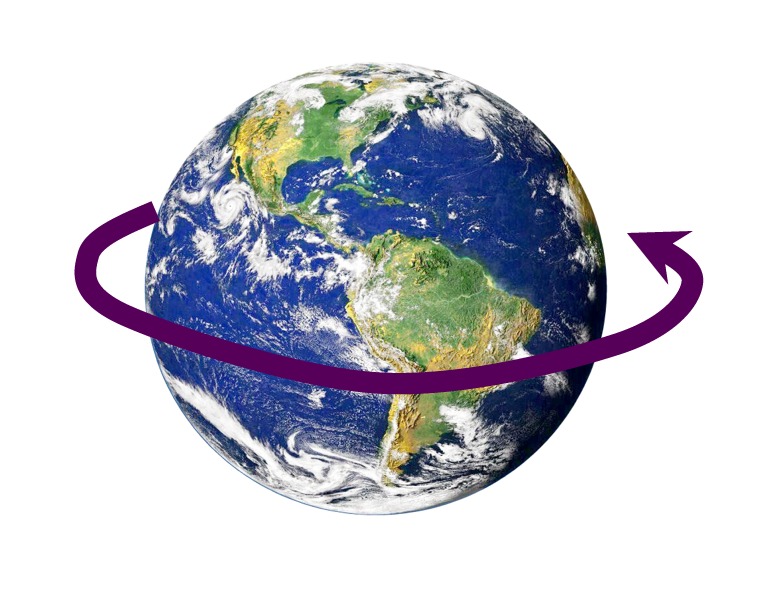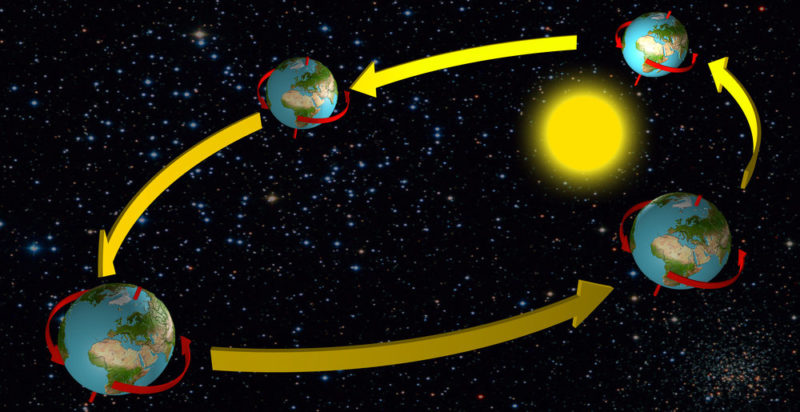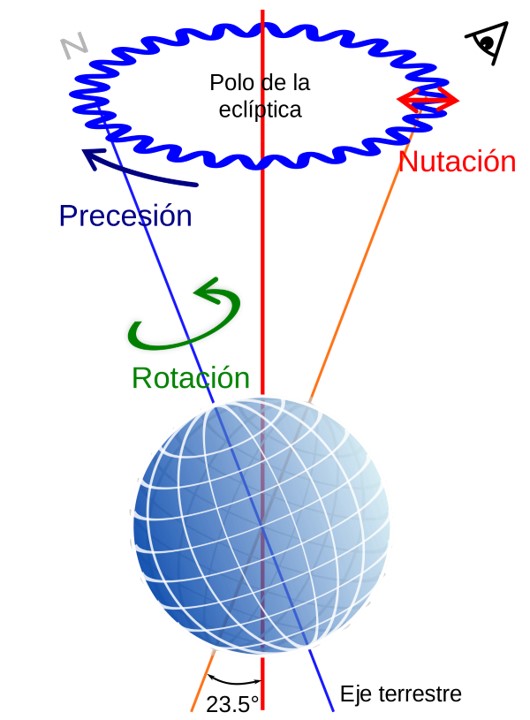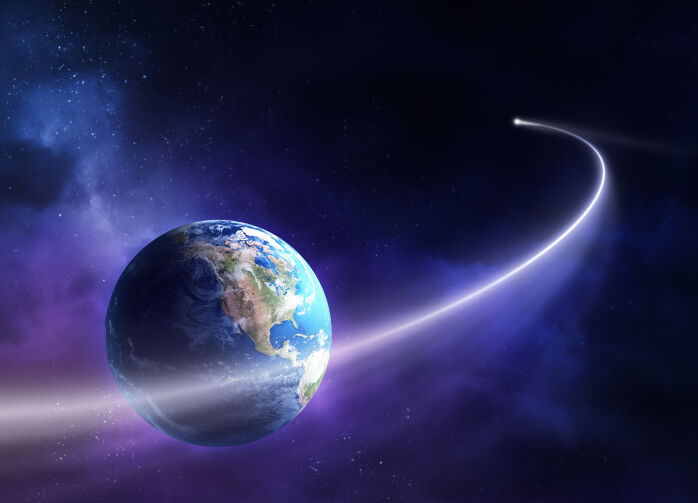The movements of the Earth are classified into 5 types, which are identified as rotational movement, translation, precession, nutation and finally Chandler's wobble. In the next article we will know what are the movements of the earth, each of its natural processes and much more.

What is the Earth Movement?
Some people will wonderHow many movements does the Earth have?? To which we respond that Planet Earth is executing a series of very particular movements, which manifest different levels due to their natural intensity. The movements of the Earth are:
- Rotatory motion
- Translation movement
- Precession Movement
- Nutation Movement
- Chandler Wobble
Rotatory motion
This type of movement of the earth is the one that is characterized by turning on the terrestrial axis, which separates the surface into 2 extremes that are known as the Poles. Said rotation is carried out from west to east, that is, a person who is observing from space over the north pole of the earth, can identify this movement as levorotatory, which means that it is counterclockwise.
When the planet earth makes a complete turn, the stars are taken as a reference or starting point, where the rotation lasts 23 hours, 56 minutes and 4,1 seconds, which is called a sidereal day. Now in the case that the Sun is taken as a reference, the meridian will pass through the front of the star every 24 hours, which is called Solar Day.
The difference between "3 h and 56 min" is because during this period the planet earth has advanced in its orbit and has to rotate a little more than 1 sidereal day to complete this solar day.
The Sun was the main reference that man took, from which his supposed movement is carried out in the rotation of the Planet Earth, which determines both day and night, which implies that the sky is moving around of the planet earth.
In the use of non-scientific language, the term day is used to refer to the period that astronomy calls Solar Day, and that corresponds to the so-called Solar Time.
Translation movement
The Movement of Translation becomes when the earth rotates in what is known as the elliptical orbit around the Sun in about 365 days and about 6 hours less, this means that it makes a movement of 1 whole year.
To a person observing from outer space over the north pole of the structure of the earth, this type of movement is also left-handed, which means that it goes counterclockwise and if it is viewed from the South Pole of the earth, this type of movement is called right-handed, which means, in the clockwise direction.
According to the fact that the calendar has always registered 365 complete days, the beginning of each year increases, which means that every 4 years, there is a year called Leap, which is the one that contains 366 days a year, this because of that does not take into account what is the equinoctial precession.
What causes the movement of translation is the action exerted by gravity and is what causes a chain of changes that, in the same way as the day, allows time to be measured.
Now, taking as a point of reference the giant star of the solar system, that is to say the Sun, the so-called tropical year, which is an important period so that during each year the well-known Seasons, so that every year after year they will be repeated without any problem.
This tropical year lasts about 365 days, 5 hours with 48 min and 45 sec "5:48:45". The movement that is described has an elliptical-type trajectory of about 930 million km, at a mean travel of the Sun that is approximately 150 million km, which can be measured as 1 AU, which is the Astronomical Unit of about 149.597.871. 8.317 km, or about XNUMX light minutes.
It is from this that it is concluded that the Planet Earth moves through its orbit at an average speed of about 106.200 kilometers per hour «km/h» which is the same as about 29,5 kilometers per second «km/s». Earth's orbit tends to be elliptical. The Solo usually occupies 1 of the foci of the ellipse and because of the extravagance of the orbit, the path between Planet Earth and the Sun varies during the year.
At the beginning of the month of January, a maximum proximity to the Sun is achieved, which produces the Perihelion, at the moment in which the journey is about 147,5 million km, while at the beginning of the month of July it is possible to reach its maximum distance, called aphelion, where the journey is about 152,6 million km. The earth's axis forms an approximate normal ecliptic angle of about 23,5°.
This kind of tilt, coupled with translational motion, is what produces long periods of extended dark and light months at the Earth's geographic poles, apart from the fact that these are the main cause of the seasons of the year, which are originating from the changes in the angle of incidence of the Sun's radiation and in what is the duration of the hours of light that produces said inclination.
What we can translate is that this type of angle is the main responsible for the fact that at the terrestrial poles there is a duration of 6 months of darkness and 6 months of light. So it is usually one of the very particular movements of the earth.
Movement of Precession of the Equinoxes
Another of the movements of the earth is the so-called Precession of the Equinoxes, which is the slight and gradual change in the orientation of the axis of rotation of Planet Earth, which is due to the so-called precession movement which It is caused by the force that is exerted by the «Earth-Sun» system itself in terms of the function of the inclination of the earth's axis of rotation with respect to the plane of the orbit, which is approximately 23° 43' in the present.
The movement is completely carried out every 25.776 years, so that more or less every 130 centuries the seasons will be reversed, however, the difference between what is the sidereal year and the tropical year can be incorporated and also corrected by the Gregorian calendar and a person observing from space, located over the north pole, would come to see it as a right-hand rotation which consists of a clockwise direction.
In the case of the tilt of the earth's axis, this usually varies from about 23° to 27°, because it will depend on other causes of all telluric movements. Approximately in the month of February of the year 2010, a kind of variation between the terrestrial axis of about 8 cm more or less was recorded, which was caused by a registered earthquake of about 8,8 ° on the Richter scale that affected the region of Chile. In comparison to the tidal wave and consequently the great tsunami that affected Southeast Asia in 2004, it was what displaced the earth's axis by about 17,8 cm.
Nutation Movement
The so-called precession movement is another movement of the earth and it is even more difficult if a 4th movement is considered, which is the so-called Nutation Movement. For this reason, it happens with some type of body that has a symmetrical shape or equally as a sphere that is rotating on its own axis; as a type of top or as many know it as the spinning top, which would be an excellent example, because when it falls, the precession begins.
As a result of the movement of its fall, the spike of the top will rest on the ground with much more force, in such a way that it increases said vertical reaction force, which in the end will become much greater than the weight.
When this happens, the inside of the top mass accelerates towards the top. This procedure is going to be repeated, and the movement begins to be composed of a precession that is going to be accompanied by a kind of oscillation of the axis of rotation towards the bottom and towards the top, which usually receives the Nutation term.
Chandler Wobble
This consists of a minimum oscillation of the axis of the rotation movement of our planet that usually adds about 0,7 seconds of arc within a time of 433 days to the so-called Precession of the Equinoxes. This movement was discovered by the famous American-born astronomer named Seth Carlo Chandler in 1891, and at present the causes that produce it are not known, despite the fact that various species of motion have been proposed. theories like:
The climatic fluctuations that are the cause of the changes in the distribution of the mass of the atmosphere, also of the possible geophysical movements in the lower part of the terrestrial crust, and of the variations of the saline concentration found in the sea. The sum of the Chandler Wobble and also of the other small effects is called the polar motion.
Perihelion Precession Motion
In what is the movement of translation, the planet earth comes to describe an ellipse as a movement of the earth around the sun, which is the one that occupies 1 of the foci of this eclipse, however, the other of the foci does not become stagnant, but in the same way it rotates slightly at a minimum angle of 3,84 arc seconds per century , around the Sun.
The aphelion or the moment of greatest distance between the Earth and the Sun, can also suffer this kind of advance, which still continues to be similar angularly, which tangentially is usually even greater. This type of movement has a period of approximately 34.285.714 years.
Orbital Variations of the Movements of the Earth
The orbital variations are the ones that list the types of effects in sets that all the changes in the movements of the Earth are those that provoke in the climate for space of thousands of years. The term came to be coined after numerous studies carried out by the renowned Serbian astronomer and geophysicist Milutin Milanković.
In the year 1920, it was assumed that the resulting variations caused cyclical changes in what is the solar radiation that usually reaches the earth's surface and that all this was going to considerably influence the models of changes weather conditions on planet Earth.
Certain similar astronomical theories are those that had been advanced in the course of the XNUMXth century by recognized men such as Joseph Adhemar, in addition to James Croll and others, however, the verification of it was a little more complex due to the lack of information. of the important fossils and because it was not very clear what times were of greater importance in the past in order to verify it.
Currently, the geological materials referring to the surface of Planet Earth that have not changed over the course of millions of years are being analyzed by all the great specialists in order to find out what are the changes in the climate of the planet.
Although many of these men are adamant to the idea of the Milankovitch hypothesis, there is a small group of researchers who say that predictable hypotheses may not be able to explain these events.
Milankovic cycles
The past and also the future of the Milanković cycles are what help to understand the forecast of all the orbital parameters that have passed and that will happen in the future in a precise way. The diversifications in the orbital elements, as it becomes:
- The obliquity that is the orbital inclination
- The Eccentricity
- Periastron Length
- The Equinoctial Precession Index
Which, together with the obliquity, are what control the seasonal cycle of what is insolation. In this way, an amount of insolation appears that is calculated day by day in the upper region of the atmosphere in the course of the summer solstice at a latitude level of about 65º N.
A very important point to be considered is the Fundamental Forces of Nature, which are taken into account by many experts since they have an impact in some cases on what are the movements of the earth.
About 2 different levels arise for what is the sea level and also the ocean temperature, these 2 levels are achieved through what many know as marine sediments and the other is extracted from the ice of Antarctica, taken from benthic deposits and the so-called ice core found at the base of Vostok Russian Antarctica.




